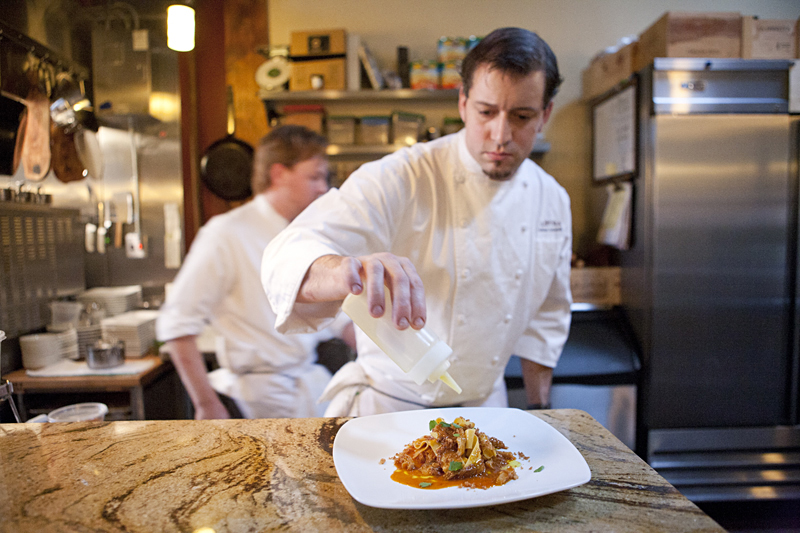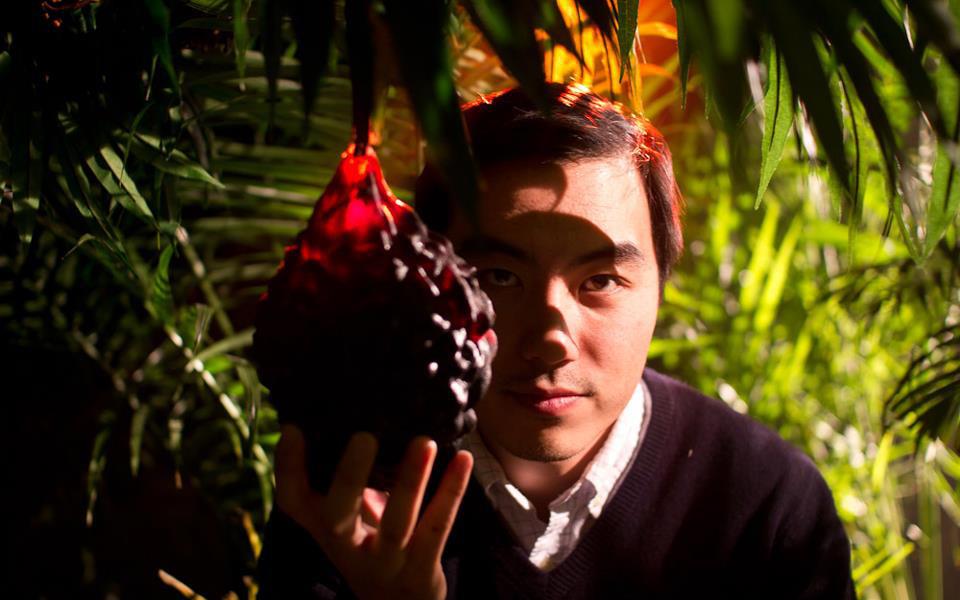The base model menu at Altura, chef Nathan Lockwood’s new temple of Italian cooking atop Capitol Hill, is a three-course meal. At $49, it includes an appetizer, pasta, and entrée. Or pasta, an entrée, and dessert. Or, if you’re feeling long in the sweet tooth, three desserts.
Altura—often more Italian in its passions than its ingredients—doesn’t micromanage its guests’ orders; the servers here won’t smirk if you wish to thrice summon beef to the table. But freedom begets curiosity, so diners tend to tack an order of sweetbreads to a meal’s start or make room for a cheese course at its close, ultimately fabricating five-, six- and seven-course feasts. Lockwood’s restaurant supplements the selections with niceties that have vanished from other restaurants of similar caliber: There’s a slosh of aperitif, an amuse-bouche, and a hunk of bread, perpetually replenished without reprobation.
With so many dishes to dispatch, Altura’s servers have frequent occasion to visit their tables. And even when they’re not within earshot, their calm presence is palpable in the most reassuring way: The salvaged wooden angel which hovers above the snug dining room is an incarnation of hospitality as practiced at Altura.
The servers’ comings and goings are unobtrusive, but rarely wordless. There’s nothing artificially sterile about the dining experience at Altura, which, with its book-stuffed shelves and timeworn wall tapestries, resembles the rathskeller of a foothills inn you’d be very lucky to find after a trying drive on twisty, snowy European back roads. So the servers explain, advise, tempt, and tease, deciphering every dish when it arrives, then floating away with an appropriate salutation. (“Health and happiness” was one server’s standard parting wish.)
It’s an idiom, of course, but Altura’s reception has been so rapturous that the idea of its tortelloni inducing miracles feels halfway believable. If the food here can change lives and shorten the distance between diners and God, as online reviewers have testified, might it not also grow hair on balding heads, soothe strained hips, and obliterate seasonal affective disorder?
Perhaps I ordered the wrong dishes, but my health and happiness are about the same as they were before I first visited Altura. I don’t expect to live forever, and I still can’t fly. I had a pair of excellent dinners, but I’m not sure the gushing volume shouldn’t be dialed down a notch or two, an ambivalence that surfaced every time I was confronted with imperfectly cooked pasta or struggled to recall the precise flavor of a sous-vide sturgeon hours after I’d left the restaurant. I am sure the raves are creating a difficult situation for Lockwood and his hardworking crew, who are now being held to standards that are stupefyingly high—the meaning of altura, as it happens. Diners who don’t have a spectacular meal at Altura report back with the chagrin of a child who’s learned Santa Claus is a hoax.
Still, those quibbles are with civilian critics, not with Altura, which routinely instills plainspoken dishes with artistry and elegance. If I wasn’t overwhelmed by deliciousness, I had no trouble finding evidence of it.
While other foods have lately bolted from the humble to the hot category, cauliflower is holding down the fort abandoned by oxtail, pig’s feet, and pimento cheese. Unlike those potentially objectionable foods, cauliflower’s ivory florets must seem painfully benign to gourmands, who don’t consider Peter Rabbit a suitable culinary role model. Yet Altura has debauched cauliflower in the most riveting way, stirring its essence into a cream-thickened soup shot through with a racy Calabrian chili oil and garnished with bits of cauliflower and broccoli that the menu calls “caramelized” and I’d call burnt. The dish is all the better for it: An appealing acridity, boosted by the saltiness of just enough capers, gives the sophisticated soup a lively bounce.
Altura is adept at adding one more element to a dish—such as the split hazelnuts surrounding a molded squash custard adorned with a tangle of crispy squash shoestrings and fried sage leaves—which makes them a shade more polished than similar dishes served elsewhere. Atop tissue-thin petals of fatty kobe beef carpaccio, nestled in a wood shavings–like pile of curling cabbage and jagged matsutake mushrooms, the lagniappe is a frankly darling quail egg, quivering on the dividing line between raw and cooked. Alongside a knob of pink pork loin, wearing a roll of pancetta like a fascinator, it’s a plump baby turnip, far more glorious than most vegetables plucked from the ground.
Absent the turnip, the pork loin—laid atop a scribble of pear mostarda—would still be pretty terrific. Meats were consistently impressive over the course of my two visits to Altura, a product of smart sourcing and precise cooking. A comely top sirloin cap steak, a lean cut which is often toughened by inexact grilling, was admirably tender. Even better was a slab of grilled venison, primeval in its blood-red patina, goosed with cocoa and joined by a sauerkraut thick with mustard seeds. While Altura usually sauces its dishes in dots and darts, the venison sat in a puddle of earthy Barolo marinade.
Every pasta dish I sampled was delicate—with the possible exception of a trio of lava lamp–shaped gnocchi paired with a sweaty wild-boar ragù—although a few lacked the snap of flavor the sauce descriptions promised. Firm matsutake ravioli didn’t ring of the woods, as dishes with a wild provenance should, and tuna-heart fettuccine, which tantalized with a whiff of the ocean, petered out on the palate. The tajarin I tried was floppy. But I was fond of a pappardelle swathed in a purposefully messy tripe-and-oxtail ragù that had a strong backbeat of heat.
Lockwood exercises tremendous integrity in sourcing, an attribute I saw in action when I watched a cook do something with orange juice. Nothing on the menu that evening was advertised as being overtly citric, so I’m not sure where the juice went. Maybe he was concocting a gastrique. Maybe he was pouring himself a glass in hopes of staving off a winter cold.
Speaking of mixers, Altura has a hard-liquor license, but keeps a bar no more elaborate than what you’d find in your average four-star hotel room. The servers will gamely mix Manhattans and martinis if asked, but guests are meant to drink wine. There are official pairings—$37 buys three courses’ worth—but the servers are also dependable if you need, say, a versatile white to see you through two different pastas and a plate of scallops. There’s no reason not to entrust all your important food and drink decisions to the talented servers here.
But back to the OJ. Non-starring ingredients give restaurants a chance to skimp. Yet Altura’s juice didn’t come from an oversized aluminum can but a shapely bottle, the kind used for pedigreed juices that aren’t mostly water.
I spied the juice from my perch at the open kitchen’s counter, which might be the best place to sit at Altura. The food there is designed to be discussed, not devoured—should you string together a nearly perfect dinner-and-a-movie evening by heading to the nearby Harvard Exit after eating, plan on ordering lots of popcorn—and the cooks have much to contribute to the conversation. “I poached these myself,” one told us, pointing to the quinces on a plate of vanilla gelato speckled with balsamic vinegar. “Let me know if you have any questions.”
The fabulous dessert was a celebration of simplicity, great ingredients, and attentive craftsmanship. Not everything is flawless at Altura, but those vinegared quinces made me very, very happy to be in the restaurant’s care.
Price Guide
Three courses $49
Four courses $59
Five courses $69








